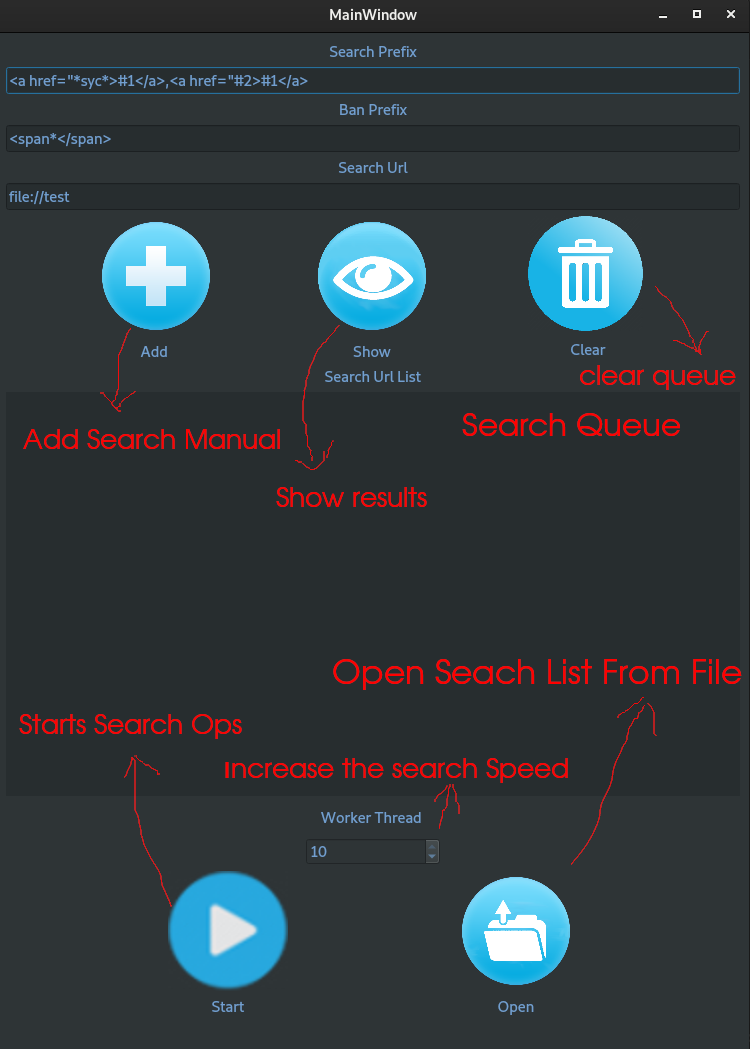Hello everyone, In these days which the unit price of data is higher than oil, everyone’s problem is finding data and categorize it. We can find all kinds of data on the internet, and thanks to google, it is now easy to access any data. But, The data in the internet is available as a stack and complex manner. I developed the this SearchingBot App to find the desired data in specific web page or file. We can make a search in specific Web-File URL or URL List which got from previous searches. Therefore, You can create a specific search batch.
I have written the app in Qt-C++ and a little bit Qml. You can compile it for Windows, Linux, Mac, Android and also ios. I have tested on Android and Linux.
You can reach source code and linux compiled program on my github account; https://github.com/electronicengine/SearchingBot
You can find the compiled code for Android and Linux x86_64 from this link;
https://github.com/electronicengine/SearchingBot/releases
App Usage:
The search prefix is the descriptor of the desired data. It can be html tag, link or any of descriptor of data. The two types of prefix;
Invalid Prefix: * this prefix is used for the complete unknown part of the prefix. For example, you can type app* rather then apple, applet, appreciated… etc. SearchBot completes the prefix according to search.
Valid Prefix: # this prefix is used for extract the desired data from prefix. It is like a variable. You can define multiple of that. Therefore every valid prefix has a variable number. For example #1, #2, #3 … #9. You can define at most 9 times of valid prefix in the one search.
Offset Prefix { } this prefixes are used for giving offset to the searched page. In some cases, You may want to take only some part of page for searching. For this purpose, you can use this open and close offset prefix.
Example Search:
For example, If I want to get the “Desired Data” section from this content;
garbage text-start offsettext sometexthere <a href="somelink-dir">Desired Data</a> sometexthere close offsettext-garbage text
I can make a search with this prefix;
start offsettext{<a href="somelink*>#1</a>}close offsettext
Searching bot extracts the sections place where is “#1” from all of content, and list them in file. If you don’t need to offset prefix, don’t use it.
As a result;
Content: sometexthere <a href="somelink-dir">Desired Data</a> sometexthere Search Prefix: <a href*>#1</a> Search Result: Desired Data
You can also enter multiple prefix and extract multiple data set by using valid prefix. For Example, You can extract “Desired Data”, and the link section from above content with this search prefix;
<a href*>#1</a>, <a href=#2>#1</a>
Notes; You can not use valid and invalid prefix without any latter between them.
as a Result;
Content: sometexthere <a href="somelink-dir">Desired Data</a> sometexthere Search Prefix: <a href*>#1</a>, <a ref=#2>#1</a> Result: Desired Data || somelink-dir
Ban Prefix:
Ban prefix is used for removing undesired data from extracted data. For example, Consider that example
Content: "sometexthere <a href="somelink-dir"><span> undesired data </span>Desired Data</a> sometexthere" Search Prefix: <a href=*>#1</a> Ban Prefix: <span>*</span> Result: Desired Data
You can use multiple ban prefix by putting “,” between them and also invalid prefix “*” in it.
Split Prefix:
Split prefix is used for splitting the desired data by one specified char
Content: sometexthere <a href="somelink-dir"><span> undesired data </span>Desired-Data</a> sometexthere Search Prefix: <a href=*>#1</a> Ban Prefix: <span>*</span> Split Prefix: - Result: Desired || Data
File Operations:
You can save and load a text file to app by using file buttons in the App. Files can be used for adding multiple search prefixes, ban prefixes and also URL’s
For example, If you have a file like that;
search url1 || ban prefix1 || search Prefix1 search url2 || ban prefix2 || search prefix2 search url3 || ban prefix3 || search prefix3 search url4 || ban prefix4 || search prefix4 .... || .... || ...
You can use it for sequential adding by using [1], [2], [3]…. [9] keywords. The numbers are indicating the column number. For Example,
Search Url : [1] Ban Prefix : [2] Search Prefix : [3]
with this entry, App understands that will put first column to “Search Url”, second “Ban Prefix” and third “Search Prefix”
Result: Search Queue 1; Search Url : search url1 Ban Prefix : ban prefix1 Search Prefix : search Prefix1 Search Queue 2; Search Url : search url2 Ban Prefix : ban prefix2 Search Prefix : search Prefix2 Search Queue 3; Search Url : search url3 Ban Prefix : ban prefix3 Search Prefix : search Prefix3 Search Queue 4; Search Url : search url4 Ban Prefix : ban prefix4 Search Prefix : search Prefix4 ...
Also you can use that column keywords with other keywords like that;
Search Url : Begining[1] Ban Prefix : Someban, key[2] Search Prefix : someprefix[3]
file:// Descriptor: You can make a search in a file rather than web page. the file descriptor is used for specifying the name of the file which is saved by previous searching.
Example usage:
Search Url: file://<file-name>
The application local directory is /home/user/.local/share/SearchingBot in Linux
file://external/ Descriptor: If you want to make search in external file, you can specify that file directory with external keyword.
Example usage:
Search Url: file://external/<file-path>/<file-name>






